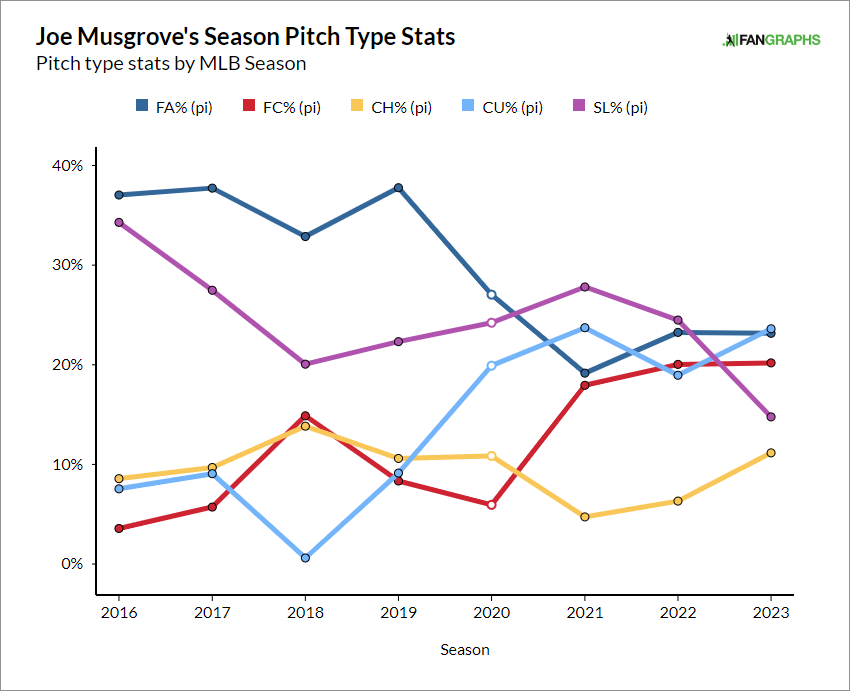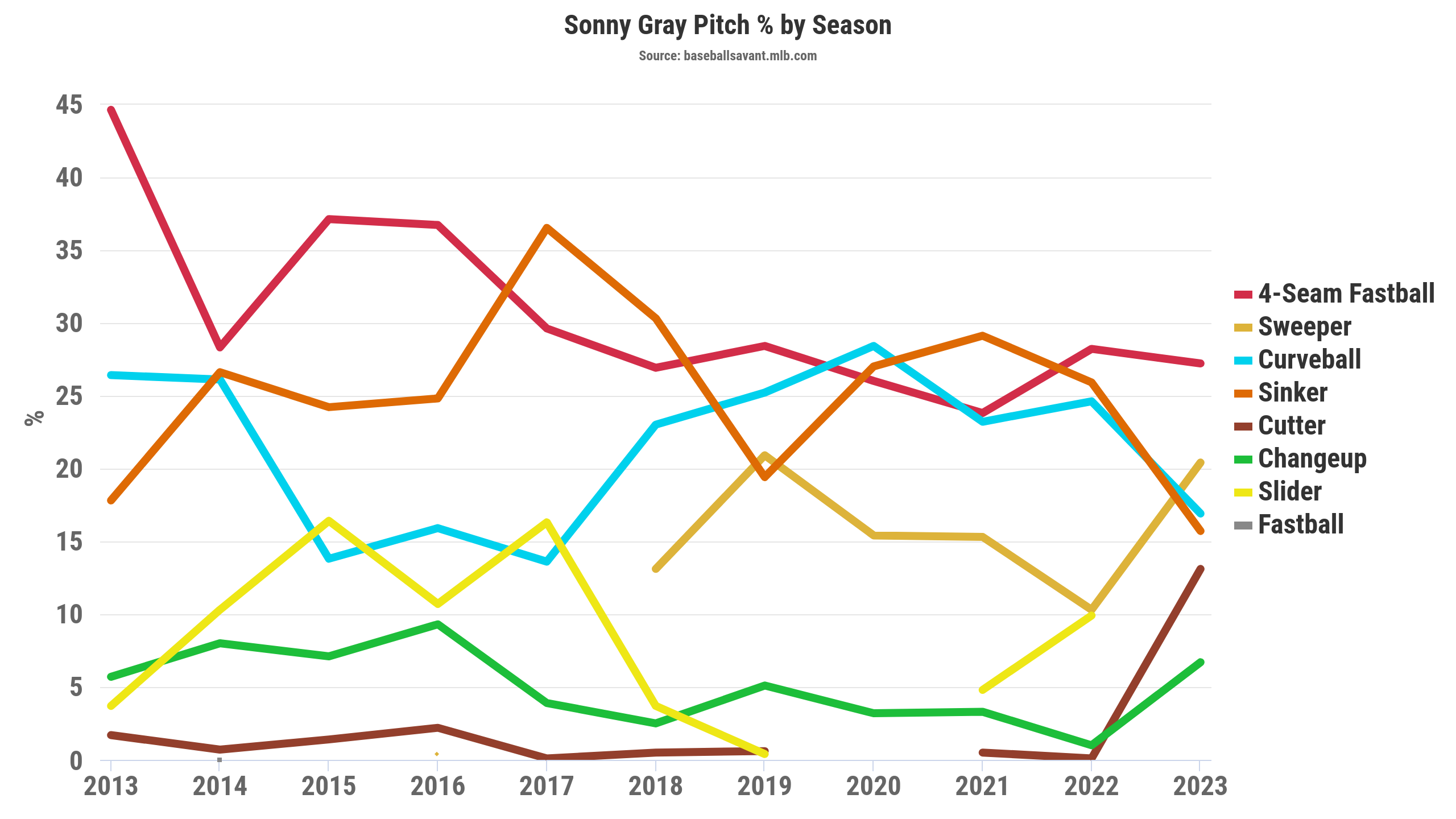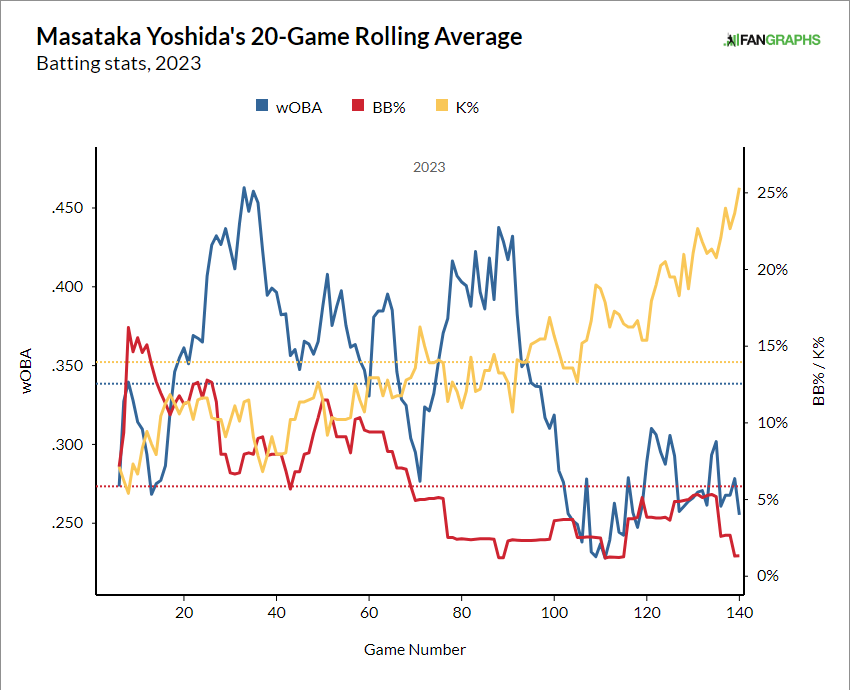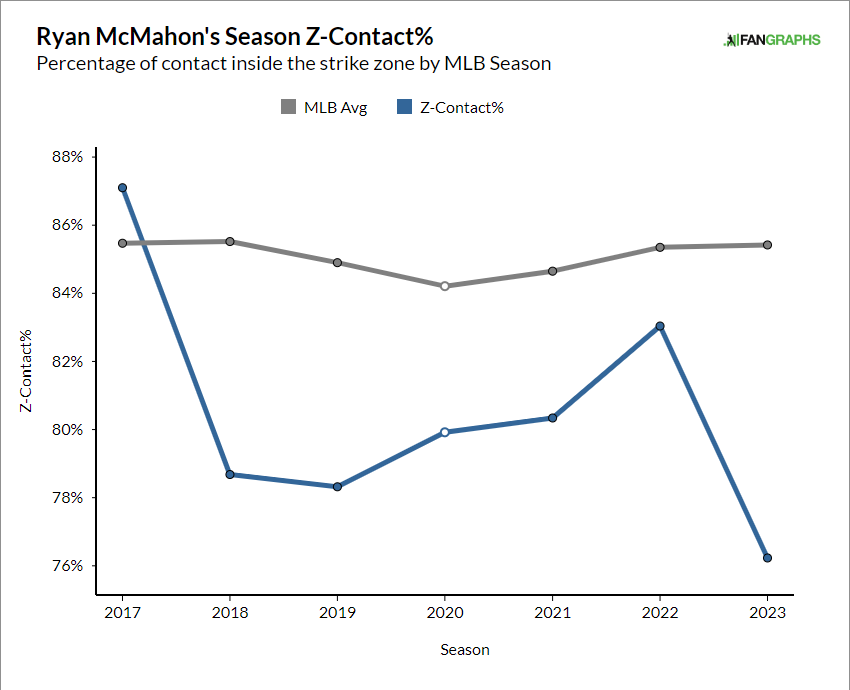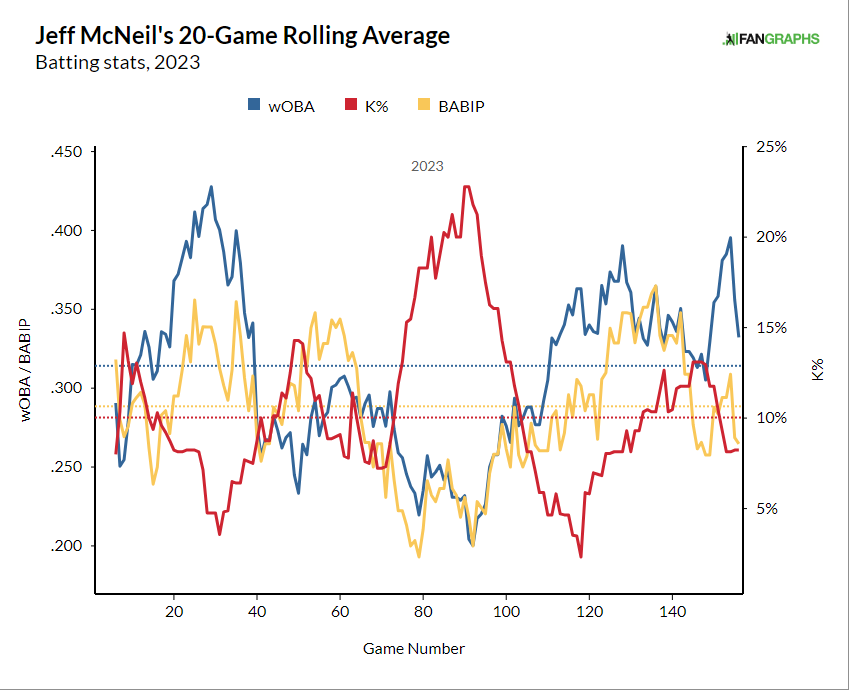In a previous post, I created benchmarks for what should be considered a replacement-level player in a few of my FanGraphs points leagues. Though some may disagree with the specifics of my process, the general question we’re all trying to answer remains the same. At what level of projected P/G should you easily be able to decide on cutting a player? Here’s what I came up with for corner-infield players:
1B Replacement Level: 5.03 P/G
3B Replacement Level: 4.71 P/G
With those marks in mind, here are four players I must make keep or cut decisions on this offseason.
–
Nolan Schanuel, 1B
Salary: $3.00
Average Salary: $6.09
2023 P/G: 5.04
Proj 2024 P/G: 4.67
With 29 games under his belt in 2023, Steamer expects the 21-year-old lefty to accumulate 125 games in 2024. That’s a very big jump, but one look at the Angels RosterResource page reveals no other clear option at 1B. Sure, Brandon Drury did play 47 games there in 2023, but with a DH spot (sadly, and likely) opening up in the Angels lineup, Drury will likely spend most of his time there. In addition, if you look at Eric Longenhagen’s June write-up of the top prospects in the Angels system, there’s not a single projected first baseman in the 28 players analyzed. Schanuel has a defensive path forward. The next question to ask is, how’s his defense? If you’re on the hopeful side of the argument, don’t read this excerpt from Michael Baumann’s September Schanuel piece:
Amateur first basemen have a low ceiling because of their limited defensive potential, and anyone who’s playing first base at 18 or 20 years old usually isn’t going to end up stealing a lot of bases when he’s 28 or 30.
In 244 innings at first base, Schanuel recorded -2 Defensive Runs Saved (DRS), meaning his defense cost his team two runs. The best first baseman with at least 200 first base defensive innings, Carlos Santana, saved his team 11 runs by DRS while the worst, Spencer Torkelson, cost his team 11. Schanuel landed a little worse than right in the middle of the first base DRS spread, which is as unhelpful as it gets when it comes to this evaluation. The Angels could very well add first-base depth this offseason to hedge their bets.
Regardless of his defensive ability, he soared through three minor-league levels in 2023 as a recent draft pick to then make his debut with the big-league boys in mid-August. That’s where he began to catch people’s attention, slashing .275/.402/.330 in 132 plate appearances. Among rookies in 2023, the average K% was 25.8% and the average BB% was 8.1%. Schanuel did better on both of those marks, striking out only 14.4% of the time and walking 15.2%. That points to some serious upside in 2024 in the OBP department, but with a big sacrifice in power. Steamer projects the following slash line:
.258/.364/.407
With such a short track record to go off of, I’d like to see what ZiPs has to say about Schanuel as it projects with more of a similarity score process. The problem is that in a FanGraphs points format, walks don’t pay the bills like slugging ability and Schanuel’s projected 4.67 points per game sinks him down into replacement level.
Keep or Cut?
If I were rostering him for anything over $3, I would cut. Yes, he is projected to be under what I would consider “replacement level”, but I’m going to keep and hope and gamble that Schanuel’s development will be important to watch and that the upside is there given his plate discipline. Michael Baumann’s take:
…he’s only 21 and is lean in such a way that it wouldn’t surprise me if he put on more muscle in the next couple years. It’s not a huge stretch to imagine him as an elite all-fields line drive hitter.
That sounds right to me, and I’ll take the gamble in 2024.
–
Alex Bregman, 3B
Average Salary: $32.24
Salary: $34.00
2023 P/G: 5.79
Proj 2024 P/G: 5.96
Alex Bregman is projected for a higher P/G mark in 2024. Here’s a slash line comparison to help understand how:
2023: .262/.363/.441
2024: .267/.367/.458 (PROJ)
It’s a very small, almost insignificant difference. Basically, Steamer thinks Alex Bregman will be Alex Bregman and maybe he’ll hit one or two more doubles. Steamer simply split the difference between Bregman’s 2022 23 home runs and his 2023 25 home runs, projecting him for 24 in 2024. That was a sentence with a lot of twos!
But, here’s a valuable statistic; between 2017 and 2023, which cuts out Bregman’s partial rookie season, the third baseman has accumulated 3981 plate appearances, good for 16th on a leaderboard full of big-time players. He finds himself on the VIP list of players like Freddie Freeman (1st, 4308), Francisco Lindor (2nd, 4305), Paul Goldschmidt (3rd, 4285), and Marcus Semien (4th, 4273). Bregman’s track record of volume and 20+ home run potential make me just want to keep him at $34, but we’re not there yet! There have only been four seasons in Bregman’s career where he has missed the 20 HR mark:
2016 – 8 HR (short rookie year)
2017 – 19 HR (missed by 1!)
2020 – 6 HR (pandemic, duh)
2021 – 12 HR (injury)
Now, how does that translate to value? According to the work I did creating tiers for all offensive players, 5.96 P/G is tier two status, and tier two players were paid $18 on average. But 5.96 P/G is close to making it out of tier two and into tier one. I’m willing to pay for tier one where the average price jumps to $29. There are also no available third basemen as of yet and I don’t think there will be come cut date. In this particular league, José Ramírez ($56), Rafael Devers ($35), Manny Machado ($34), Bregman ($34), Austin Riley ($27), and Nolan Arenado ($24) are the highest paid and though I would like to have Bregman closer to $30, I don’t think I could get him back for that price at the draft.
Keep or Cut?
Keep!
–
Matt Mervis, 1B
Average Salary: $4.74
Salary: $4.00
2023 P/G: 7.11
Proj 2024 P/G:
Who is Matt Mervis, really? Hopefully, he is not his 2023 27-game slash line:
.167/.242/.289
Hopefully, Mervis can do better than the RosterResource red highlight that signifies he is in a “Projected platoon vs RHP”. Hopefully, he makes the big league club this spring and moves up slightly from the eight spot he’s projected to bat from. That’s a lot of hope for $4. I, admittedly, make the mistake of giving up too soon too often in keeper formats, but I need something I can grab onto with Mervis. I’m having a hard time finding it.
Mervis struck out an alarming 32.3% (26.3% vs. R and 57.9% vs. L). With only 19 at-bats against lefties, it’s nothing to get all worked up about, but it’s not something to ignore either. It’s his power that got so many excited when he was an up-and-coming prospect and a lot of the hype came from fantasy touts after his Arizona Fall League performance. Then there’s this, from Eric Longenhagen and Tess Taruskin’s assessment of the Cubs system back in July:
His raw power is real, though. Mervis’ hands are fast and powerful, and he’s capable of hitting titanic pull-side blasts. He once hit a home run that struck the Cubs’ spring training stadium’s upper level… from their primary minor league backfield. Hanging breaking balls and anything that finishes on the inner third of the plate are vulnerable to his pull-heavy style of swinging.
How did that turn out in his short 2023 stint? As expected with the fastballs, but not so with breaking balls, mostly because he saw very few of them.

Statcast
I don’t like banking on the idea that Mervis might see lots of hanging breaking balls on the inner third. No, the truth is found if you just keep reading his prospect report beyond the “smashes breaking balls” part:
Mervis ends up being pretty long to the outer third of the zone, and big league fastballs up and away from hitters who swing like this tend to present a real problem. Mervis’ initial big league trial was pretty rough and we don’t anticipate things will get much better. He’s got a lot of Quad-A signals and we’re now receiving them.

Statcast
You can see, unhighlighted in the visual, that pitchers took advantage of the scouting report and worked him outside. But, highlighted in the visual, you see that he didn’t do much with pitches on the inside third, pitches that he is supposed to pull out of the galaxy.
Keep or Cut?
I have thoroughly talked myself out of this one. He’s a cut for me and I may just try to sneak him on my roster for $1 with the hope that the swing adjustments he was reportedly making in AAA pay off.
–
Isaac Paredes, 1B/2B/3B
Average Salary: $8.11
Salary: $13.00
2023 P/G: 5.55
Proj 2024 P/G: 5.43
This version of Paredes has received a $2 arbitration increase in each of the past two seasons, bringing his rostered salary well above the average. His projected 5.43 P/G in 2024 lowers him, just barely, into tier-three status among all offensive players with at least 75 games in 2023. But, there’s upside and it comes from Paredes’ power, or lack of power, or…it’s complicated. In a FanGraphs points format, slugging percentage is key and Paredes is projected to slug .463. The upside, however, comes from his 2023 mark of .488. In each of his big league seasons, he has increased his slugging percentage. Though his .362 wOBA doesn’t match his .314 xwOBA, his average launch angle has increased from 7.5 in his rookie season to 22.2 in 2023. He hovered around 6% with his barrel rate in 2022 and 2023 and while the league average was 8.1% in 2023, Paredes is still only 24 years old, and his MaxEV of 110.4 is respectable. FanGraphs writer Esteban Rivera examined this conundrum back in July of 2023 which is an excellent read for anyone trying to figure out Paredes. As Rivera points out, Paredes’ game is to pull the ball in the air and despite his lack of raw power, his approach and understanding of the zone allow for his actual statistics to beat out his expected statistics, allowing for sneaky good results:

Will he be figured out? Will pitchers simply focus on throwing to the outer edge of the plate, limiting his ability to get into his pull power? So far, it seems, that Paredes is covering the plate just fine:

Statcast
Isolated to only balls in the zone, you can see he’s still able to pull plenty of balls on the outer half. The visual above makes for a very broad assessment as there’s no isolation of pitches, but what I like most about Paredes’ improvements over the past few seasons is his ability to hit the fastball. His Pitch Info pVal on four-seam fastballs jumped from -3.1 in 2021 to 0.7 in 2022 to a whopping 8.4 in 2023.
Keep or Cut?
Now for the hard part. Remember that part about sneaky results? Well, the term “sneaky” no longer applies to a $13 player. Keep or cut? It’s simple, just answer the question, keep or cut?! Well, $13.00 is a lot and I may be overvaluing Paredes’ power, but I love his positional flexibility and I’m paying a little extra for the upside in 2024. I’ll keep, but don’t tell too many people.


